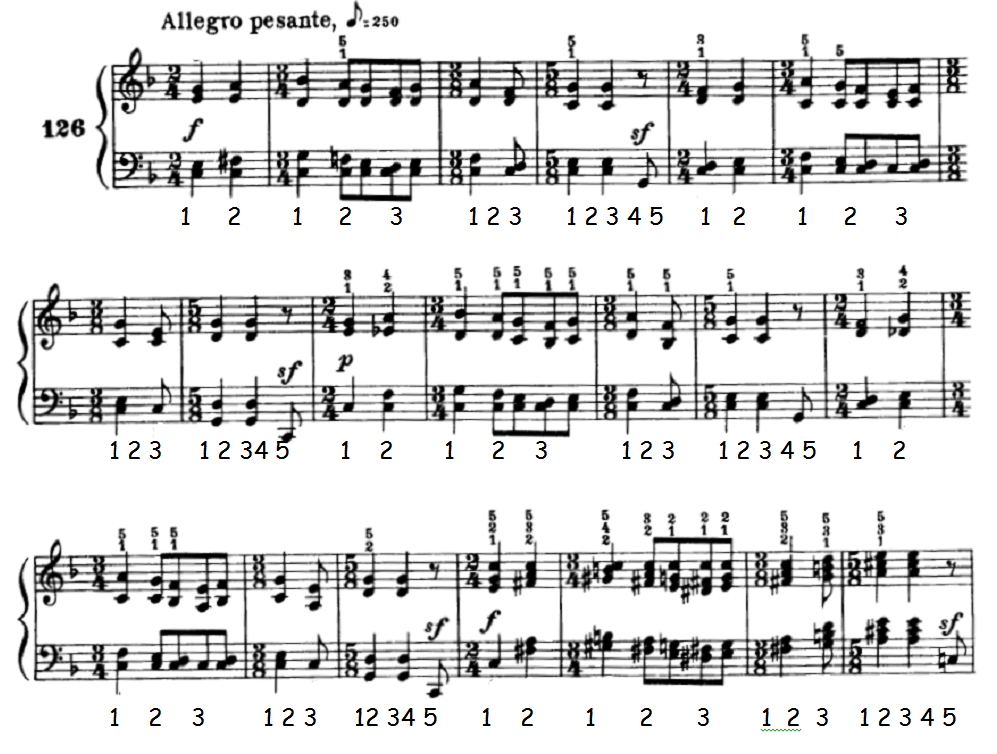

- Lilypond anacrusis measure numbers how to#
- Lilypond anacrusis measure numbers full#
- Lilypond anacrusis measure numbers code#
RE: Bar number position and text (especially for anacruses), andrew.bernard, 5.Bar number position and text (especially for anacruses),.\override BarNumber #'break-align-symbols = #'(staff-barīarNumberVisibility = #all-bar-numbers-visible \override BarNumber.break-visibility = #(#f #t #t4f/) % please note that this example "omits" the SystemStartBar, inĬase part of the solution to #2 involves choosing an object to Output so I've taken a chance and embedded an image of the output
Lilypond anacrusis measure numbers how to#
I can't find instructions on how to include or post example "pickup"? Not as important: Is that also possible for any


Can I change the text for theĪnacrusis bar number to something other than "(1)"? Like "0" or The procedure different for other individual bar numbers?ģ. Move it horizontally exactly where I want it? Not as important: Is I found commands that change the object itsĪligned to, but none of those positions were satisfactory. (think I) want the bar number for the anacrusis to appear just Nevertheless, you may find this formatter very adaptable. Partial works fine for the initial anacrusis, but if the piece has multiple parts, each with an anacrusis, the processor complains about the subsequent. \once \set Score.barNumberFormatter (lambda (bar-number measure-position alternative-number extra) (markup 'pickup')) But note that the length of the text in this case is problematic.
Lilypond anacrusis measure numbers full#
Full control over horizontal alignment of bar numbers. The problem that I'm having is that many of these tunes start both the 'A' part and the 'B' part with an anacrusis and end the part with a shorter measure to make the number of beats work out. Not as important: is there a way to raise/lower any givenĢ. There commands that would automatically ensure that all are at theī. How can I lower it, and how can I raise the others? Are

To join any number of measures: Select the measures you want to join From the menu bar, select Tools Measures Join selected measures. To join two measures only: Select the barline between the two measures Press Ctrl + Del or select Tools Remove selected range. The parenthetical bar number for the anacrusis is higher than theĪ. This command joins selected measures into one measure. Vertical alignment/positioning of bar numbers.
Lilypond anacrusis measure numbers code#
With code below as reference, please help me with:ġ. Which works?įor me, Melody #1 - the melody with the Upbeat - really feels better.Bar number position and text (especially for anacruses) Use one hand to Conduct in Triple Time, with a nice strong Pulse on the Downbeat (1). Read, Sing or Play the 2 Melodies in the Example Box here. In the Ultimate Music Theory LEVEL 4 Supplemental Workbook on Pages 34, 35 and 36, Students learn how to Conduct in Duple, Triple and Quadruple Time. I feel that you were hoping for a script-oriented way of having LilyPond generate a rehearsal mark with the current measure number (like a circled 9 or 15) whenever you use the 'mark default' command. It simply does not work!Īnd THAT is why we use an Incomplete Measure. How about singing "Amazing Grace" starting with that Strong Downbeat (Strong Pulse) on the "A" of " Amazing" (instead of beginning with an Incomplete Measure so that the Strong Downbeat is on the "MA" of "a MAzing"). Trying singing "Happy Birthday" but start with a Strong Downbeat (Strong Pulse) instead of with a weak Upbeat (weak Pulse). Why do we use an Incomplete Measure? Quite simply, it is all about the Beat and the Pulse. Incomplete Measure - Why Do we Have Them? Start adding the counts there and, when they run out of notes to write counts under, they get to head back to the beginning to finish the counting. The final measure will start with Count #1. I tell my Students that if they start counting with Count #1, but they run out of notes to write counts under, then it is an Anacrusis and they need to go to the end. On of the Ultimate Music Theory Basic Rudiments Workbook, there is an excellent exercise on how to add the counts when a melody does not start with a complete measure (when it does not start on count #1). So, start adding the counts there and, when you run out of beats, head back to the beginning and finish adding the counts. The beginning of the final measure will be Count #1. So, how is the first count of an Incomplete Measure? To figure this out, you must go to the end, to the Last Measure! It is not necessarily the first count of the melody. When a melody starts with an Incomplete Measure, it does NOT start with Count #1!Ĭount #1 is the first count of the first Complete Measure. Incomplete Measure - How Do we Count Them?


 0 kommentar(er)
0 kommentar(er)
